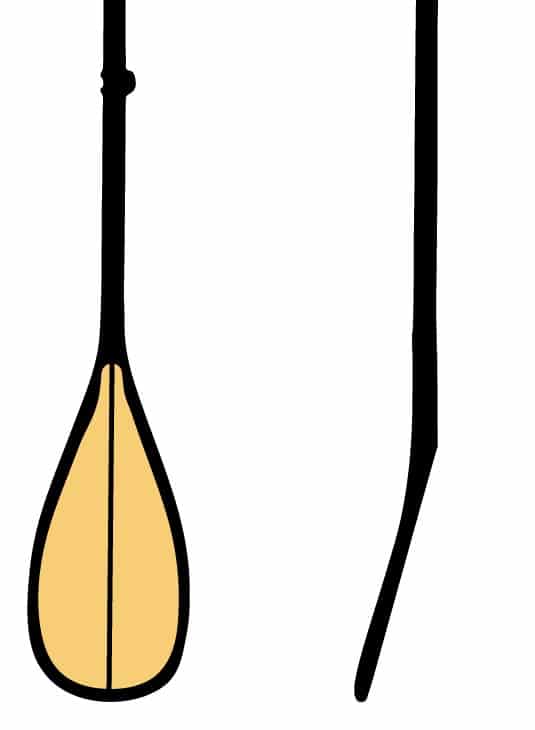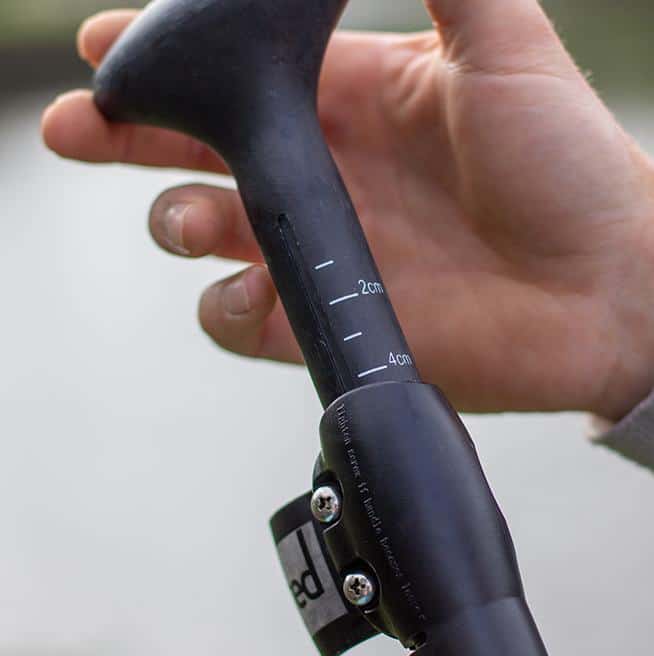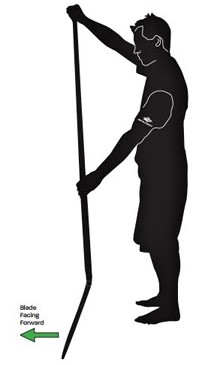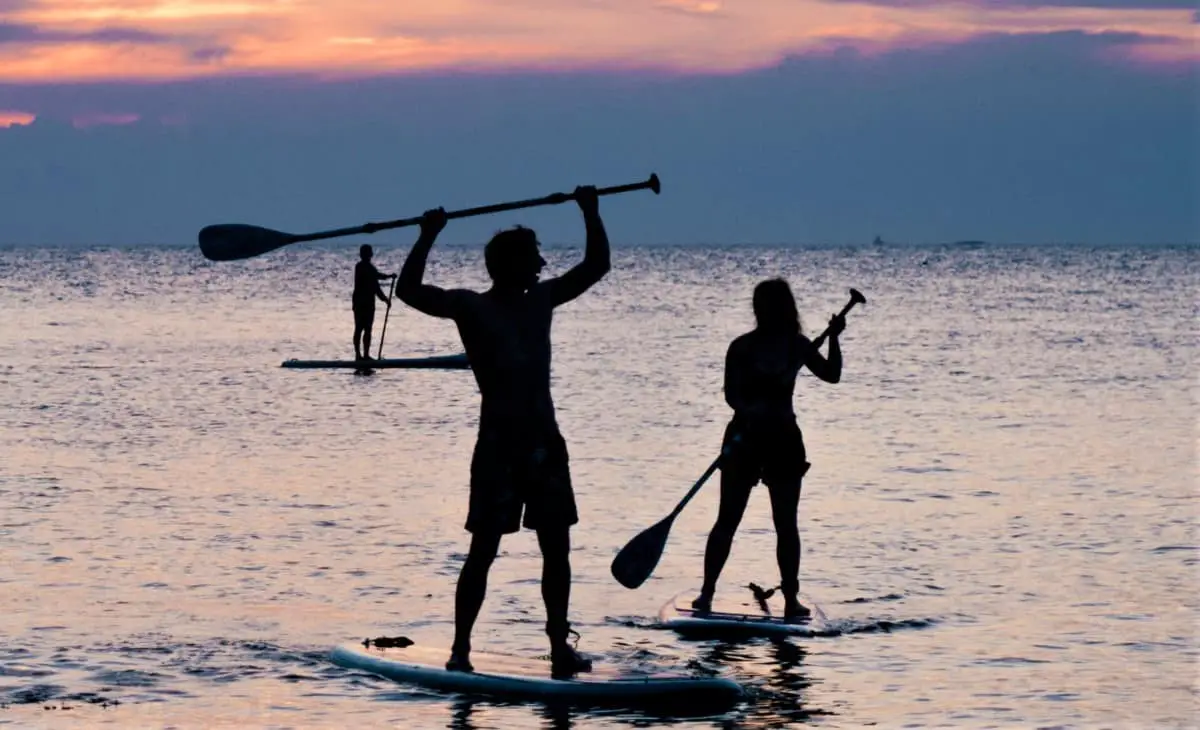
How to Choose a SUP paddle
With so many sup paddles on the market how do you know which one to choose?
The more often you paddle board the more important it becomes to pick the right paddle
When choosing a sup paddle
consider these questions:
What type of paddling will you do? All-around? Racing? Long distance touring?
Do you want a one piece shaft or an adjustable paddle?
How strong and healthy are your shoulders? Can they handle a large blade for slow power or are you better off with a small blade for quicker, easier strokes?
How much are you will to pay?

1. Type of Paddle Boarding
All-Around Paddle Boarding
The price and performance of fiberglass sup paddles make them the most popular for all-around paddling.
For all around paddling any sup paddle will work fine. What paddle you choose will be determined by how often you paddle. The more you paddleboard the lighter weight paddle you will want.
If you only paddle a few times a year a heavier entry level paddle will be fine. Spending more time in the water you will want to upgrade to a fiberglass or carbon/fiberglass blend.
Adjustable paddles are the way to go for most paddlers. Beginners need an adjustable paddle to experiment with different lengths.
Racing
Sup racers want the stiffest and lightest carbon paddle they can afford. Blade size will depend on the paddlers strength and the condition of his/her shoulders.
Surfing and Whitewater
Surfing and whitewater demand a durable paddle. The shaft should have some flex. Fiberglass is a good choice.
Touring/Long Distance
Serious long distance paddlers want the lightest paddle they can afford.
Many long distance paddlers like a little bit of flex which is easier on the joints and muscles.
A lightweight high-quality carbon/fiberglass blend is a good choice.
Long distance paddlers tend to prefer a moderate blade size to save wear and tear on their shoulders, wrists and elbows.
Women and Children
There are sup paddles made specifically for women and children. These paddles are lighter with smaller blades. The shaft and grip is smaller in diameter to fit smaller hands.
2. Blade Size
Larger blades push more water to generate more power, but you pay a price in quicker fatigue and more stress on your shoulders.
Smaller blades are easier on your body, use less energy per stroke and are best for a quicker stroke cadence.
Don’t assume you need a large blade. Most paddlers would do better with a medium or small size blade.
I prefer a smaller blade because of shoulder problems. And I find a smaller blade less fatiguing on long sup tours.
Large blades are 90-100 sq.in. Small blades are 80-87 sq.in.
Large blades :
- 90-100 sq. inches
- Generate more power
- But need more power to paddle
- Best for larger strong paddlers
- Best for well conditioned paddlers on fast boards
- Less strokes per minute
Small blades:
- 80-87 sq. inches
- Easier on all the joints and muscles
- Best for a quick cadence
- Best for dynamic turns
- Best for smaller paddlers
- Best if you have shoulder problems
- More strokes per minute with less energy per stroke
Body weight/Blade Size Guidelines
- < 150 lbs: 80–90 sq.in.
- 150 – 200 lbs: 90–100 sq.in.
- >200+ lbs: 100–120 sq.in.
Blade Shape
There are two basic blade shapes. The tear drop and the rectangle.
I wouldn’t get too caught up in blade shape. The difference is only noticeable with experience. Basically the tear-drop shape has a tad more power. The rectangle offers a faster cadence and is easier on the body.
Blade Offset

Blade offset is the degree of angle a blade has.
- 7º blade is best for surfing and whitewater
- 10º blade is best for all-around paddling
- 12º blade is best for racing

3. Adjustable vs Fixed Length

Adjustable
Adjustable paddles are the most common and popular type of sup paddle. They allow the beginner to experiment and find the perfect paddle length.
Adjustable paddles break down into two or three sections making them shorter for travel.
Intermediate and advanced paddlers like them because they can use the same paddle for long distance touring and shorten it for surfing.
With an adjustable paddle you can have one paddle for the entire family. And it can be adjusted for a friend who wants to try your paddle board.
Fixed
Fixed sup paddle are made for experienced paddlers who know exactly what they need in a paddle.
Fixed paddles tend to be a bit lighter, a bit stronger and cost a bit less. And you never have to worry about a the locking mechanism breaking.
SUP Paddle Length Tips
Length is important for proper form and paddling efficiency. A paddle that is too long will stress your shoulders and cause then to fatigue quickly. A paddle that is too short will stress your lower back.
For flat water paddling: 8-10″ taller than your height.
When surfing or whitewater river running: 4-8″ taller than your height.
Tips
- You need to experiment within these guidelines to find the best length for you. Everyone has different body proportions, longer or shorter arms, etc.
- Most paddlers fit near the middle of these guidelines.
- If you have longer arms or broader shoulders try the longer side of the guidelines.
- If you have shoulder problems try the shorter side of the guidelines.
- If your shoulders hurt from paddling your paddle is too long.
- If you have an upright style try the longer side of the guidelines.
- If you have a more crouching style try the shorter side.
- You can adjust for conditions: In flatwater a longer paddle will give you longer more powerful strokes.
- When the water gets choppy a shorter paddle will help you handle those rougher conditions with short quick strokes.
Paddling tip:
Beginners and novices often paddle too tall. Remember you must hinge forward at the hips when taking your stroke.
Read: Beginner Paddling Tips

The lightest and stiffest sup paddles are carbon fiber.
4. Paddle Materials
Better quality sup paddles are lighter and stiffer. It is the construction materials that determine the weight and stiffness.
Weight
The average paddler might paddle 1,000 strokes an hour. If you’re paddle boarding 5-6 hours at a time the strokes will add up and paddle weight becomes a real factor.
Carbon paddles are the lightest but most expensive.
Aluminum and plastic sup paddles are heaviest but cost the least.
Fiberglass paddles are in the middle for both price and weight. They are lightweight but a bit heavier than carbon.
It all comes down to how much time you spend in the water. If you are racing or taking long distance tours a lighter paddle makes sense. If you only paddleboard a few times a year a heavier paddle should be fine.
If you’re doing a lot of paddling a carbon paddle is worth the extra money.
Stiffness
Another performance area affected by construction material is shaft stiffness.
A stiff sup paddle shaft will transfer more energy to the water. Therefore more power and efficiency with each stroke.
However a paddle that has flex is easier on the shoulders, wrists and muscles in general.
Some paddlers just prefer the feel of a paddle with a little flex.
If you have shoulder problems but still want a stiff paddle for more efficiency you can try a stiff shaft with a smaller blade. With a smaller blade you will be moving less water taking stress off your shoulders.
Carbon fiber is the stiffest.
Fiberglass is fairly stiff but not as stiff as carbon.
Aluminum has the most flex.
SUP Paddle Material Guide
Aluminum
Aluminum is used for the shaft on entry level paddles. Aluminum is lightweight but still heavier than fiberglass or carbon.
Aluminum shaft paddles tend to have the lowest price.
Aluminum will feel cold or hot to the touch depending on the weather.
Plastic
Plastic is primary used as the blade and grips of entry level paddles. Plastic is heavier than the other materials. An aluminum shaft and plastic blade is a typical beginner paddle.
Fiberglass
Fiberglass is lightweight and relatively stiff. Fiberglass makes an excellent sup paddle.
However carbon fiber is a bit lighter and stiffer.
Price-wise fiberglass is in the middle between aluminum and carbon fiber.
A good fiberglass sup paddle strikes a nice balance between performance and price. Many intermediate-advanced paddlers use a fiberglass sup paddle.
Both the shaft and the blade can be constructed of fiberglass.
Carbon Fiber
Carbon fiber is the lightest and stiffest material used to construct paddle boards. It is also the most expensive.
Both the shaft and blade of high-performance sup paddles are carbon fiber.
A less expensive and popular option is a carbon/fiberglass composite shaft. Or a carbon shaft with a fiberglass blade.
For a racer or serious long distance paddleboarder the weight savings of a carbon fiber paddle is worth the price.
Every avid paddle boarder should consider a carbon fiber paddle. You will feel the difference immediately.
Wood
Some paddle blades are inlayed with wood or bamboo.
Other paddles are 100% wood. These paddles are often hand made and beautiful. Wood is reasonably light and feels great in your hands.
How to hold a sup paddle
The correct way to hold a sup paddle is with the blade angled away from your body.


